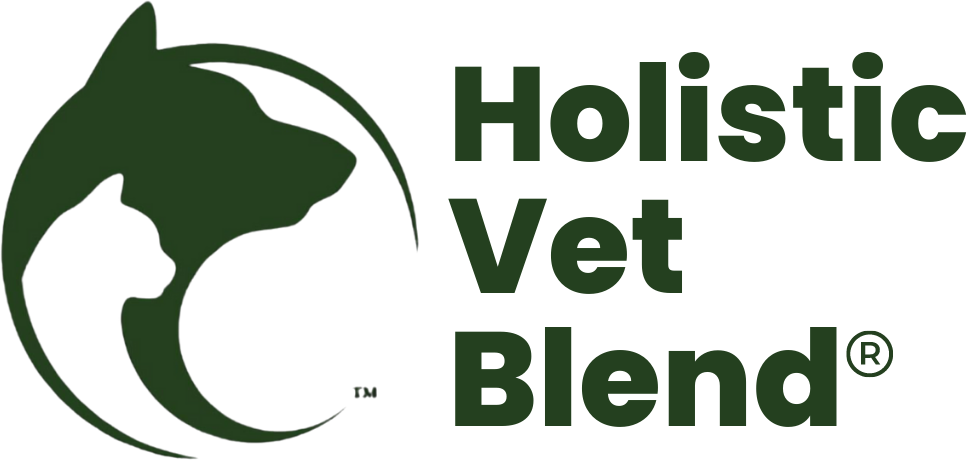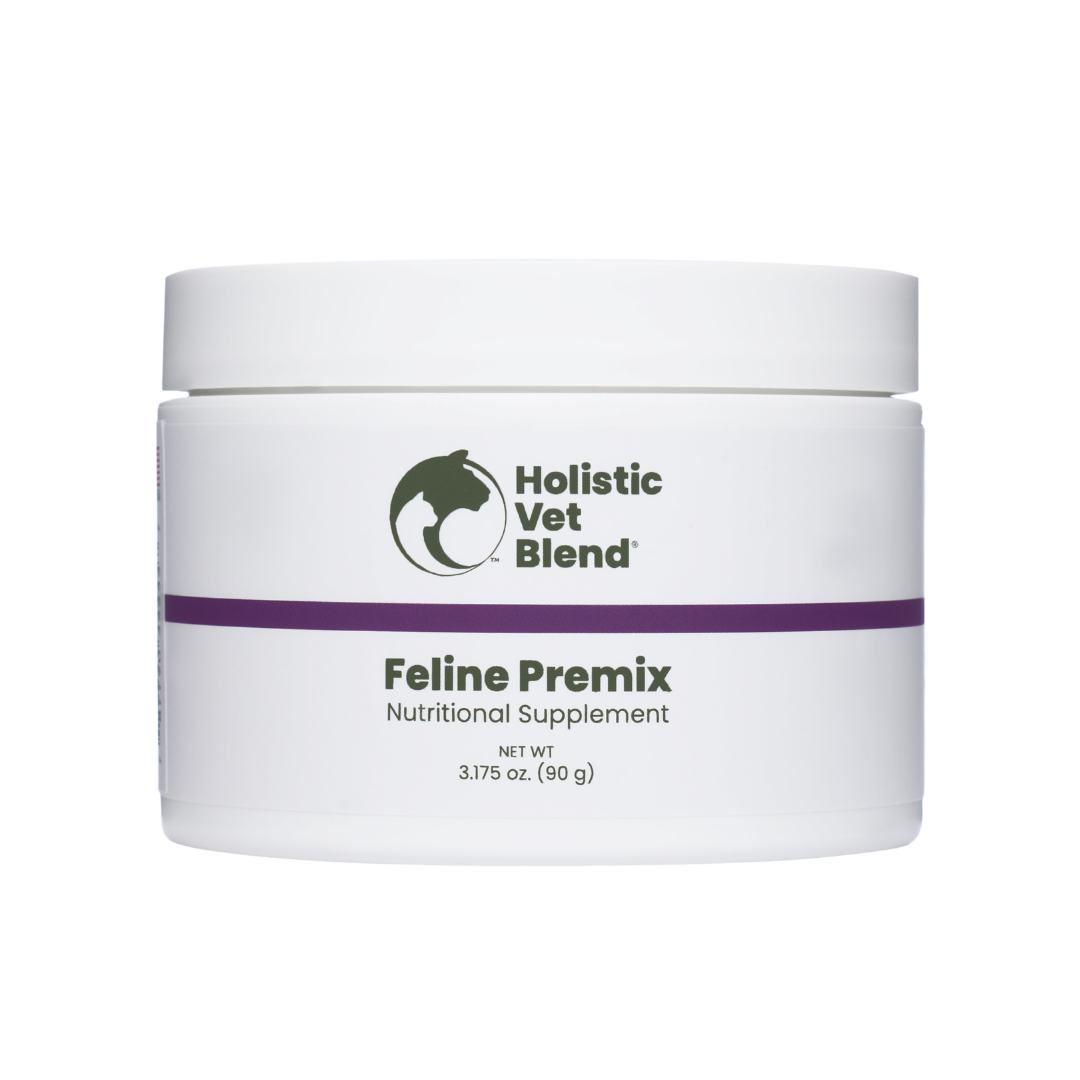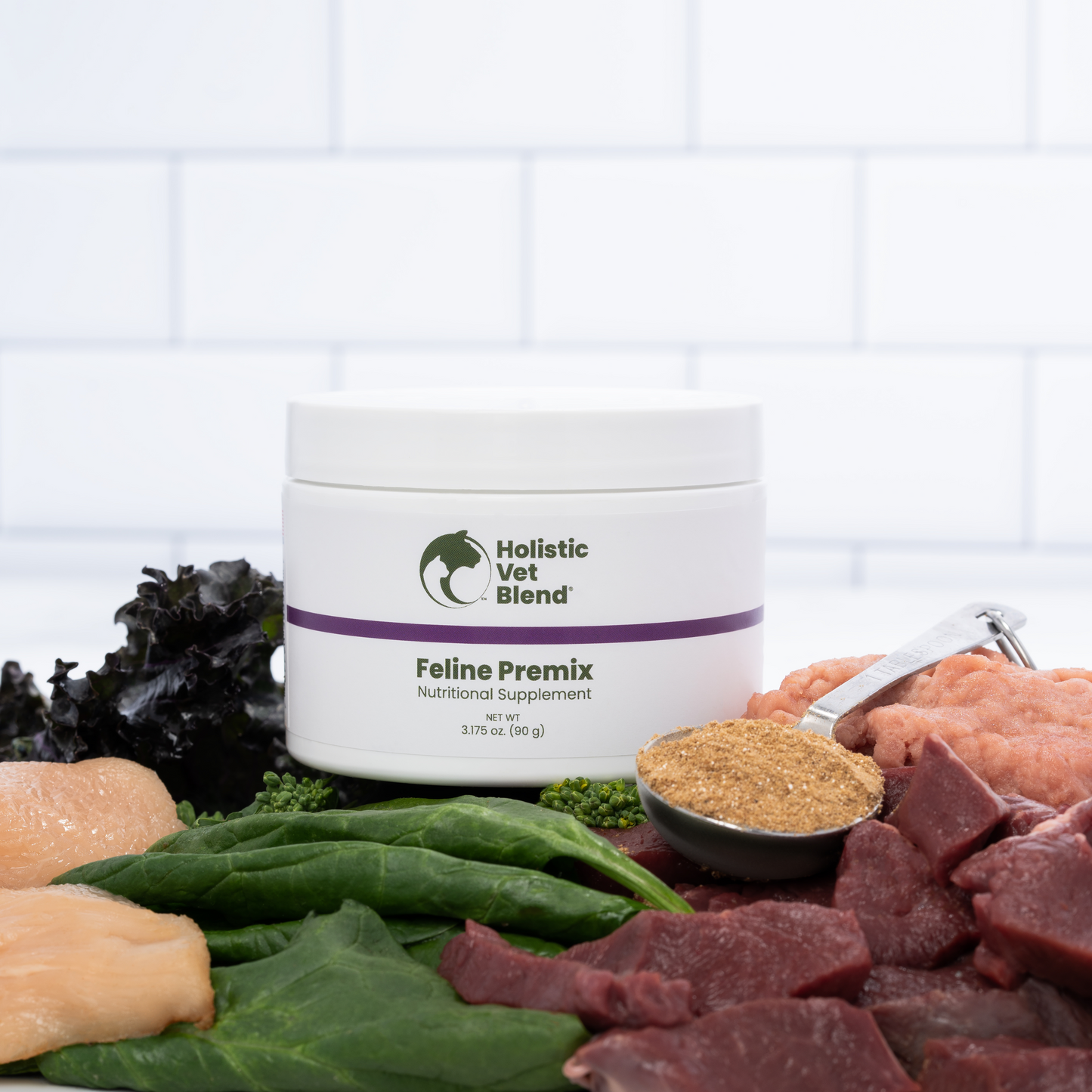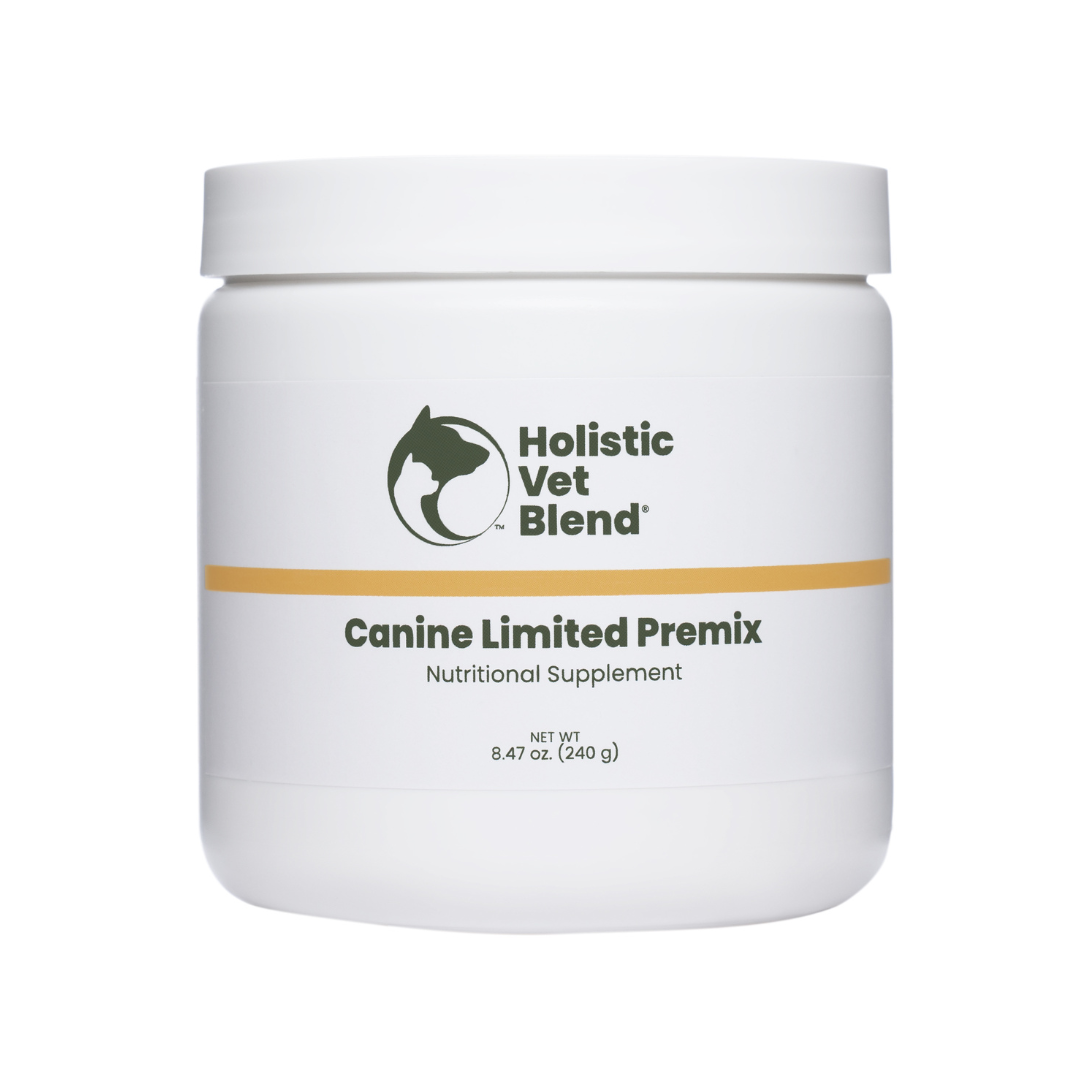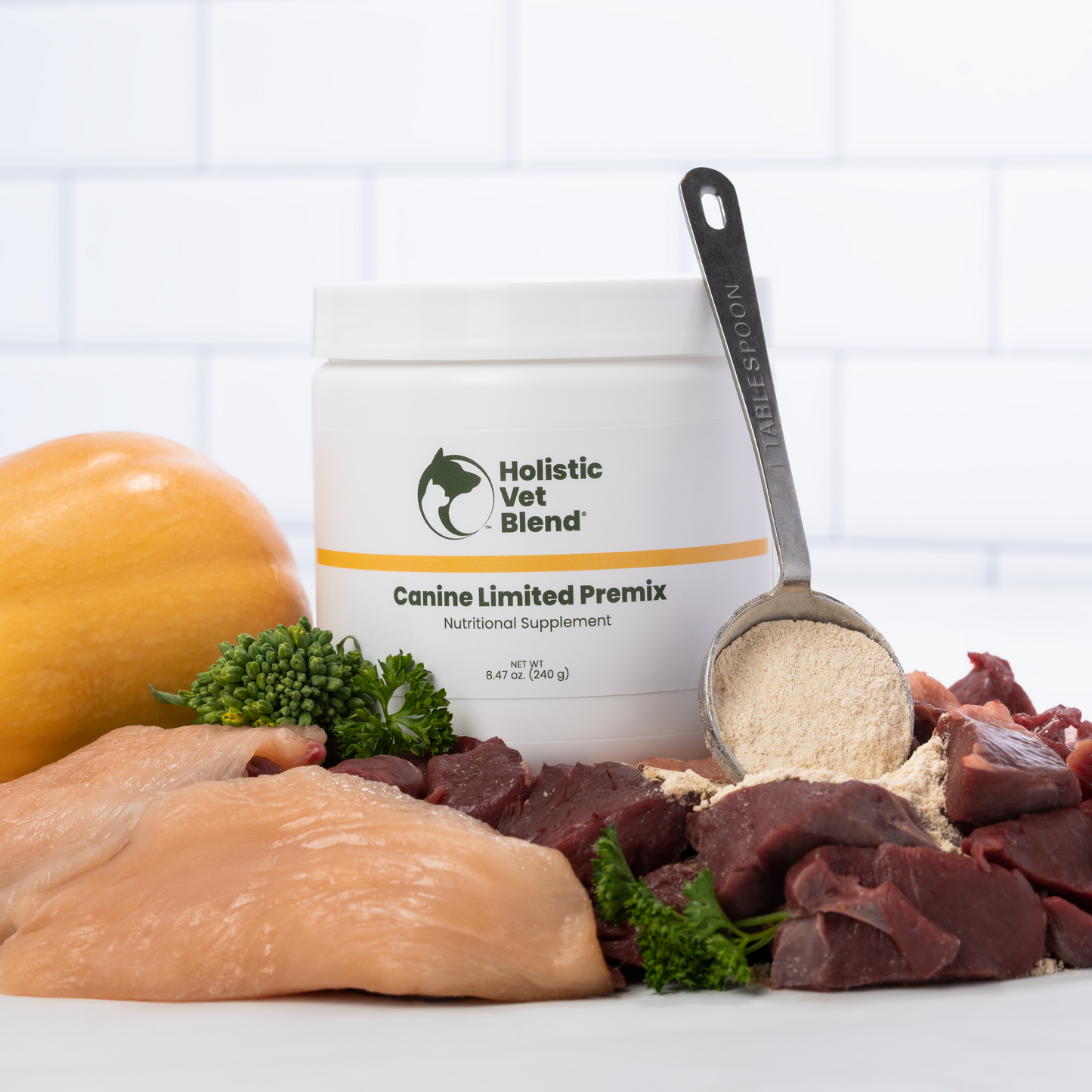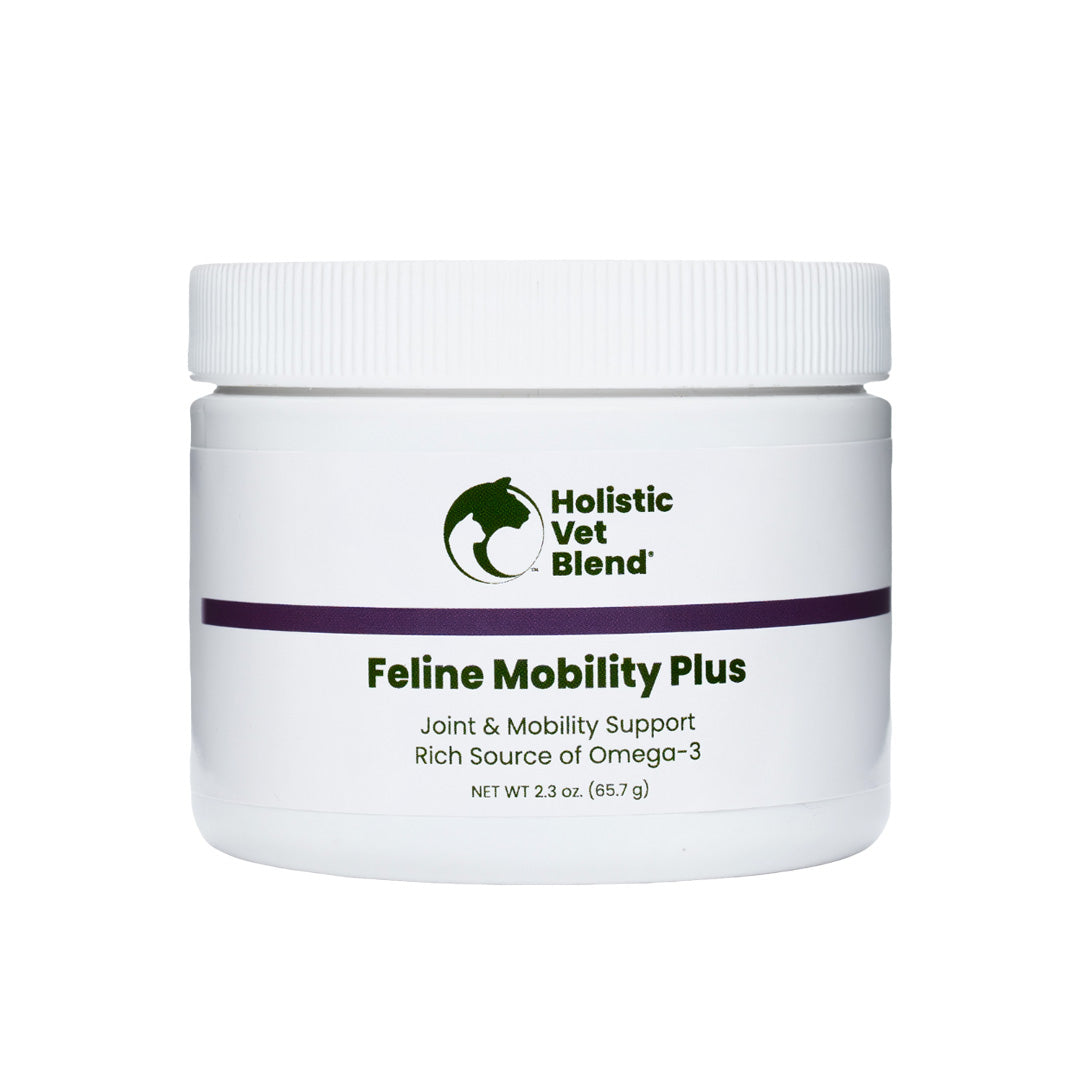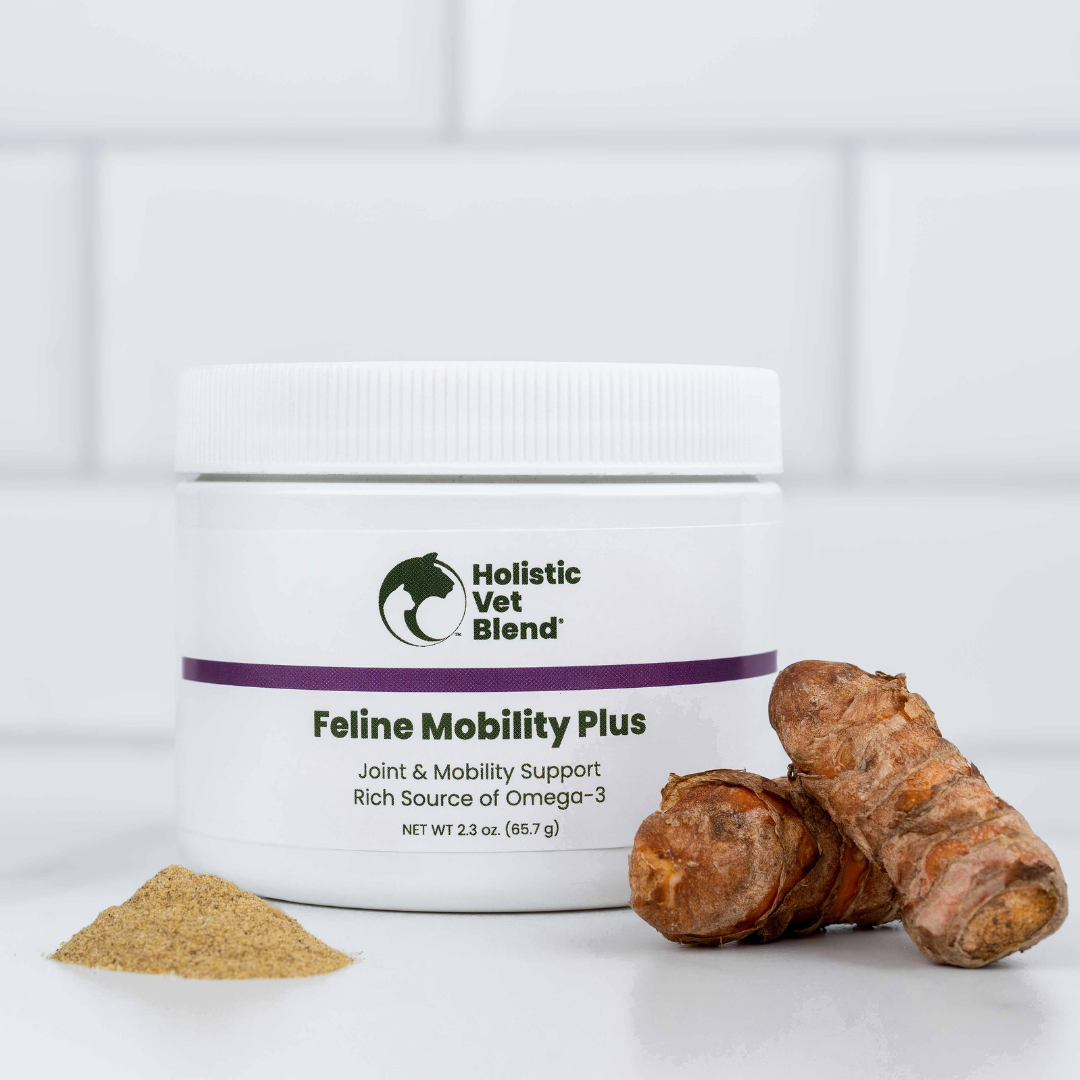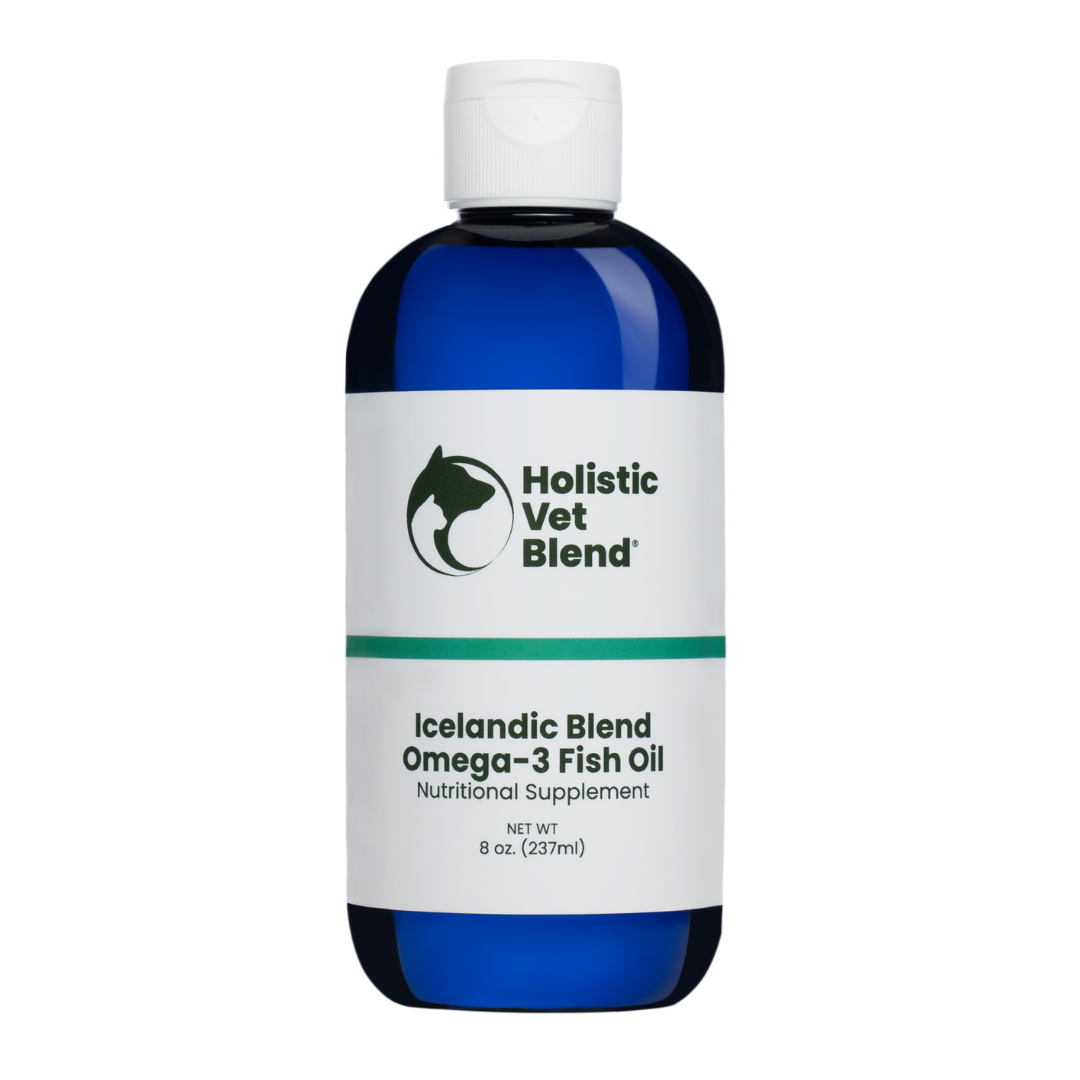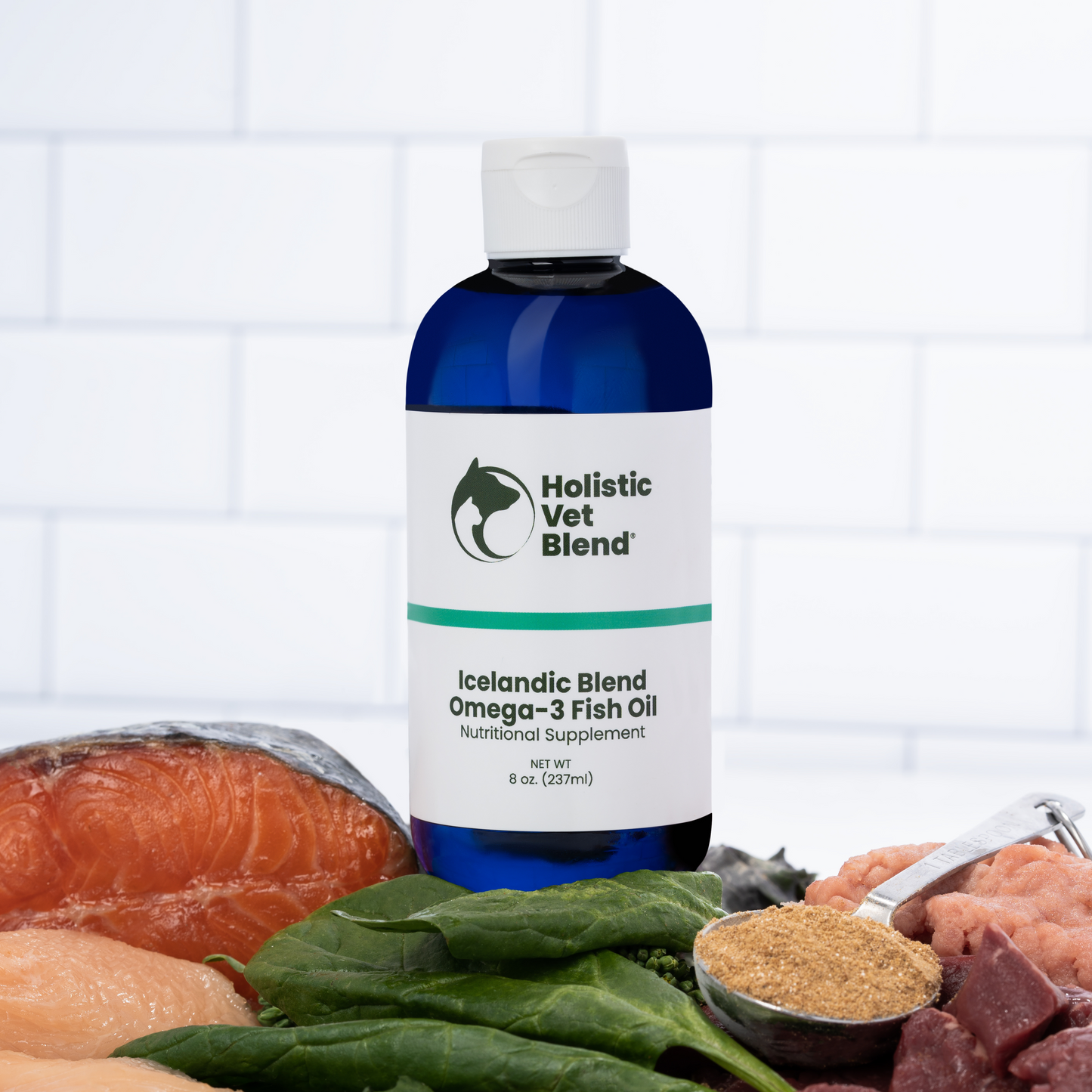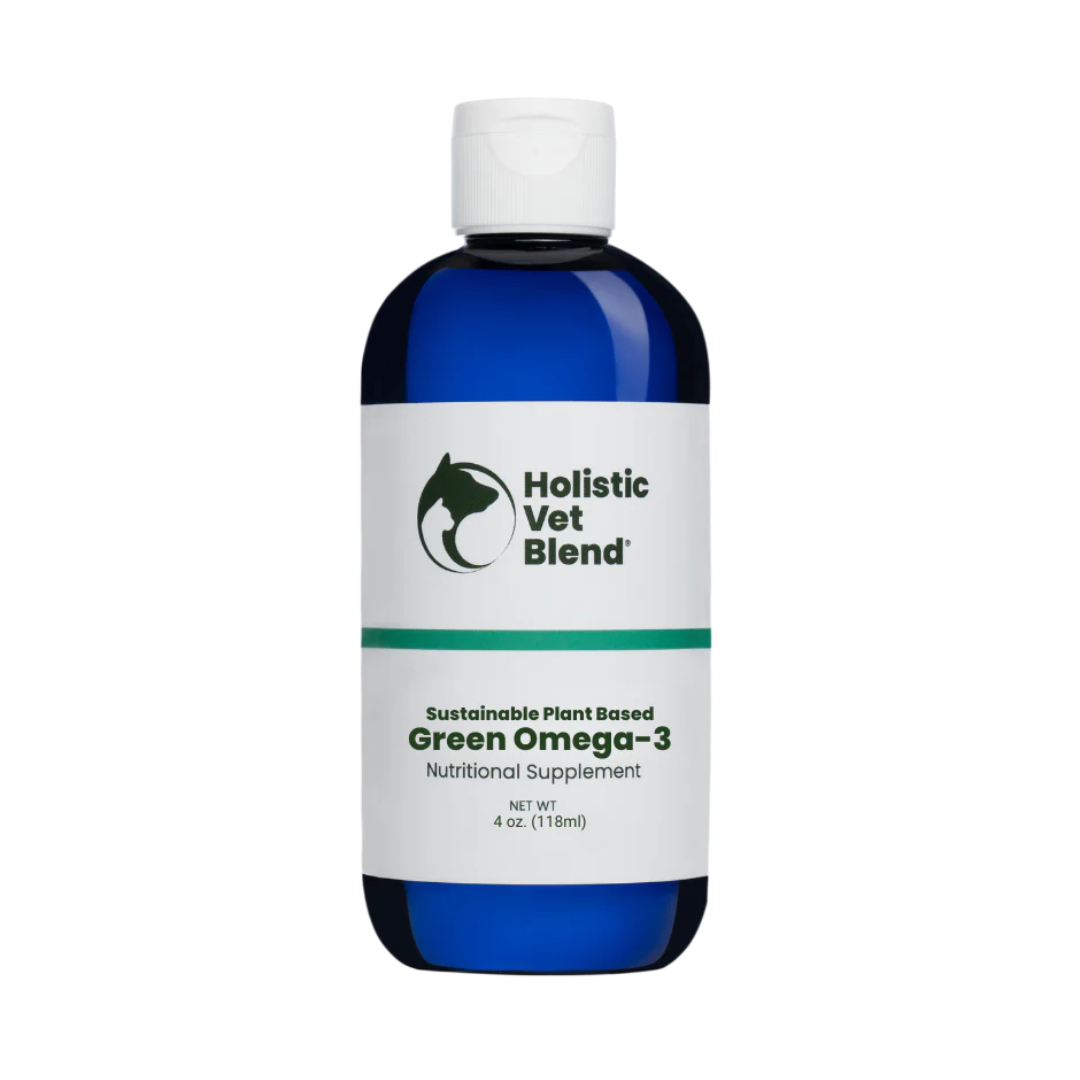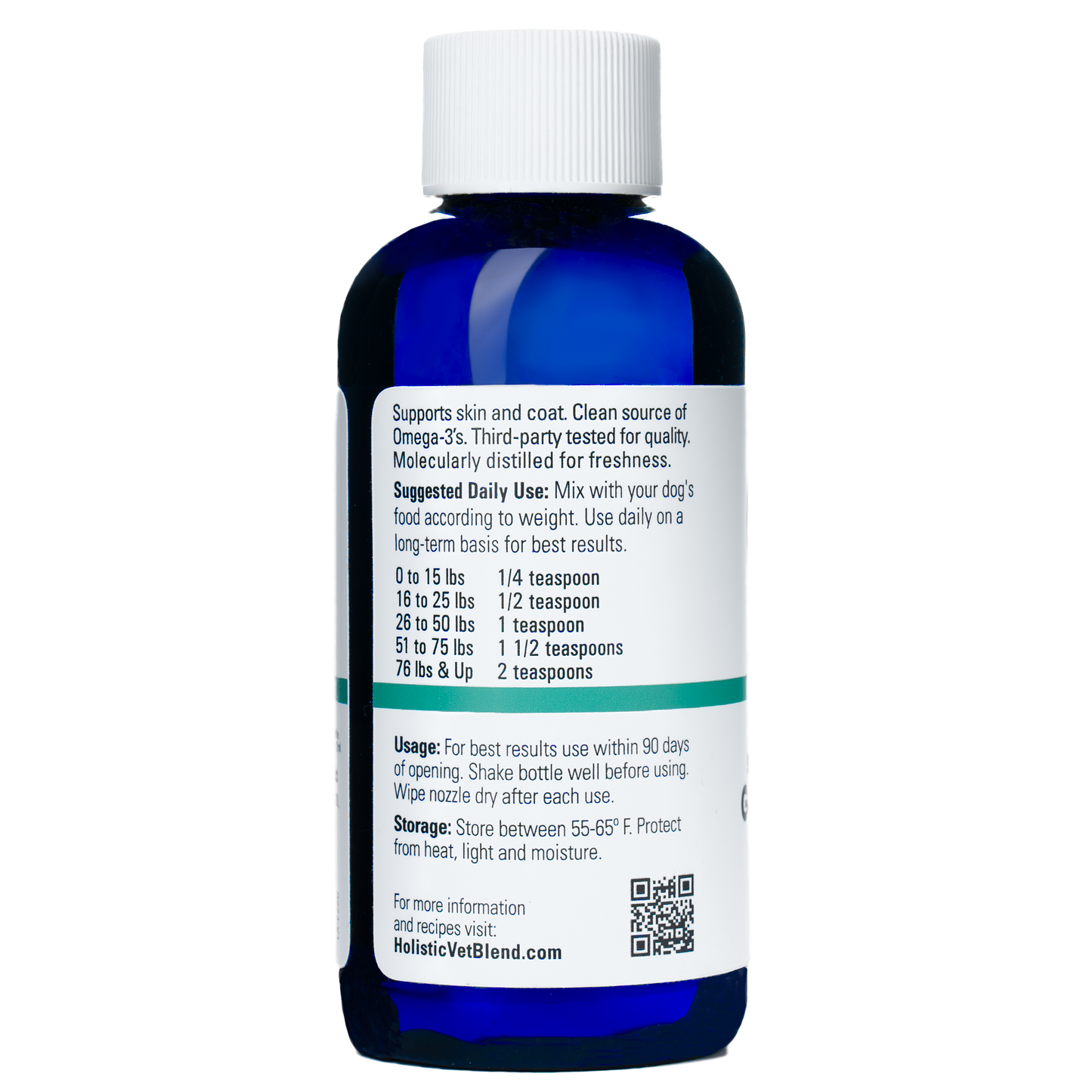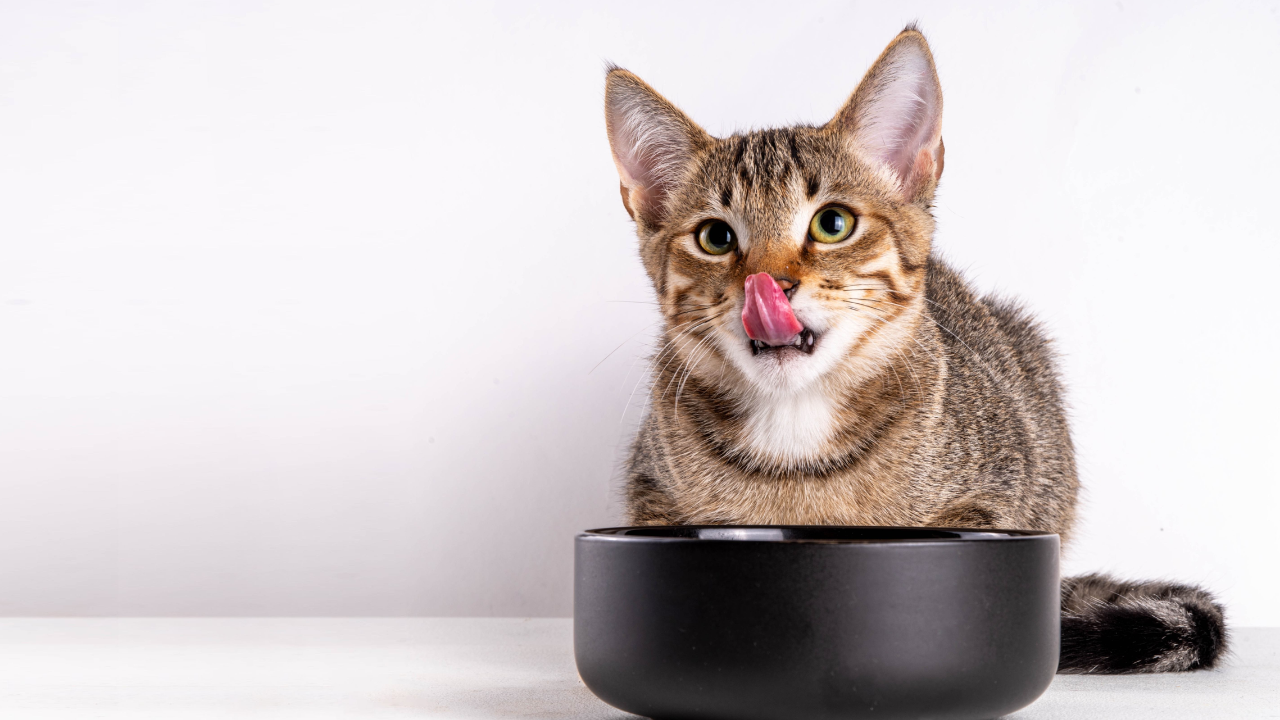
How to Assess Homemade Cat Food Recipes for Completeness & Safety
Making your cat’s food at home might sound overwhelming—but with Holistic Vet Blend, it’s actually easier (and faster) than a trip to the grocery store. In just 15 minutes, you can prepare a complete, vet-formulated meal using fresh ingredients you trust—without relying on ultraprocessed commercial cat food. Created by a holistic veterinarian with over 30 years of clinical experience and backed by board-certified animal and veterinary nutritionists, our premix was designed to bridge the gap between confusing DIY recipes and healthy veterinarian-backed recipes. It's obsevant of the cats needs as an obligate carnivore.
Most commercial cat food comes in cans or pouches that end up in landfills, contributing to the over 300 million pounds of pet food packaging waste discarded each year. With Holistic Vet Blend, you reduce waste, feed with confidence, and support your cat’s health naturally. You have confidence and control over the ingredients.
Holistic Vet Blend Feline Premix ensures your cat’s homemade meals are:
- Veterinarian-developed and nutritionist-backed
- Balanced to meet AAFCO standards for kittens to adults in our Feline Blend
- Enhanced nutrition for senior cats to provide additional B vitamins and fiber for digestive health, and formulated to be on the low end of Phosphorus for maintenance
- Made with human-grade ingredients in the United States.
- Making homemade cat food means 60-90 fewer packages or cans per cat per month, which reduces landfill waste.
- Customizable with your own organic, seasonal, or local ingredients
And this year, we’re honored to announce that Holistic Vet Blend has been awarded the “Cat Food Functional Diet Product of the Year” by the 2025 Pet Innovation Awards—a prestigious international competition that celebrates innovation and excellence in pet wellness.
Award-Winning Quality You Can Trust: Our premix was selected from thousands of products based on its safety, usability, and impact on pet health. We’re proud to set a new standard for homemade cat food nutrition. This recognition isn’t just a gold star. It’s a powerful validation that our premixes aren’t just convenient—they’re a truly vet-approved cat diet solution that meets the rising demand for real-food, natural nutrition for pets.
Introducing Holistic Vet Blend Feline Premix and the Holistic Vet Blend Senior Feline Premix
Our award-winning feline premix was designed with the expertise of a holistic veterinarian, board-certified veterinary nutritionists, and PhD-level animal nutritionists. It’s your solution for making balanced homemade cat food—whether raw or cooked.
- Formulated to meet AAFCO standards for kittens to adults
- Includes essential vitamins, trace minerals, and fatty acids
- Perfect for picky eaters and sensitive stomachs
- Works with raw or cooked recipes (currently, we recommend cooking especially with poultry, due to the risk of bird flu)
- Ready in under 15 minutes per batch of food
You prepare your protein (such as ground turkey) and greens, then mix in our premix and healthy oils, like fish oil or algae oil. No need for measuring 10 different supplements.
Understanding and Managing the Calcium to Phosphorus Ratio in Cat Food
There are many misconceptions surrounding feline nutrition. A key misconception for some cat owners is that protein should be restricted, when in fact they actually have an increased requirement for protein as seniors. Restricting protein can cause muscle loss, as cats will mobilize their own body stores if they do not get enough in their food. One key modification is lessening the amount of phosphorus they consume as part of their diet. Phosphorus is the second most abundant mineral in the body and is an essential nutrient for cats; however, excessive phosphorus intake can put a strain on the kidneys over time and negatively impact their urinary tract health. Additionally, it's important to consult on the use of vitamin supplements for your cat's dietary needs.
Chronic kidney disease (CKD) is very common in older cats, and research has linked high-phosphorus diets to kidney damage in otherwise healthy cats. As cats reach middle age and beyond, it becomes essential to limit phosphorus intake to help protect their kidney function and urinary tract health. This is why nutritional guidelines suggest making dietary adjustments for mature and senior cats, including options like chicken thighs – to accommodate their changing metabolism and organ health needs. By reformulating our Feline diet into a lower-phosphorus “Senior” blend, we are addressing the natural changes in cats’ physiology as they age.
Holistic Vet Blend Feline Adult vs. Senior: Our original Holistic Vet Blend Feline diet (an all-life-stages/adult formula) was formulated to meet a target of ~1.25 g/1000 kcal, aligning with standard minimum maintenance requirements. By contrast, the Feline Senior formula was formulated to meet the minimum requirements set by the NRC (0.75 g/1,000 kcal). We feel the lower NRC Phosphorus maintenance standard provides senior cats with all the phosphorus and the amount of calcium they require for health. In other words, Holistic Vet Blend Senior supplies just enough phosphorus (along with a proper calcium balance) to avoid deficiencies, while minimizing any excess that could burden an aging cat’s kidneys.
Feline vs. Senior Formula: What’s the Difference?
|
Feature |
||
|---|---|---|
|
Life Stage |
All Life Stages |
Adult Maintenance |
|
Phosphorus Level |
~1.25 g/1000 kcal (low end AAFCO maintenace) |
~0.75 g/1000 kcal |
|
B Vitamins |
Maintenance |
Higher levels for absorption |
|
Fiber |
Maintenance |
Added psyllium for hydration |
|
Kidney Support |
Maintenance |
Formulated to reduce kidney burden |
Our Senior formula mirrors prescription kidney diets; however, it does not go below the recommended maintenance diet level. It’s ideal for aging cats or those with early-stage kidney concerns.
The Problem with Homemade Cat Food Without the Right Nutrients
It’s easy to assume that if you’re using fresh, high-quality ingredients, your raw homemade cat food must be healthy. But the most important fact is that even the best ingredients can lead to problems if they don’t deliver the nutritional value your cat needs.
Studies have shown that most online recipes are lacking in essential nutrients, including taurine, vitamin E, calcium, and B vitamins. These gaps can result in:
- Vitamin A deficiency in cats → Neurological issues, vision loss
- Taurine deficiency → Enlarged heart, blindness
- Calcium imbalance → Bone loss, fractures in growing cats
The problem is that these deficiencies appear over time. One client shared a story about a senior cat who had gone nearly blind on a plant-based diet—the owner thought she was just “slowing down.” It turns out, she was suffering from avoidable deficiencies that developed over time.
This is why it's not just about feeding raw meat or skipping dry food—it’s about balance, and that’s where our nutrient-rich cat food premix comes in.
Raw Feeders: What You Should Know
A raw diet can offer biologically appropriate nutrients—but it’s not without risks. for cat parents. Cats continue to die from exposure to bird flu from raw diets. Although it is rare, it is more likely that sick animals slaughtered for meat will end up in pet food, unfortunately. Also, animals that are sick don't always appear so and may end up in the food supply.
The Bird Flu Issue
Recent bird flu outbreaks have led to recalls of raw poultry and, in rare cases, deaths in cats. While uncommon, the risks are real.
Our current recommendation: Avoid raw poultry. If you want to use poultry, be sure you cook it. When feeding raw, opt for alternative meats, such as beef or lamb, to minimize exposure to pathogens. Light cooking maintains nutrients and protects both your cat and your peace of mind.
Specialized Formulas and Diet Types for Cats (Including Homemade Raw Cat Food vs. Cooked)
Making your cat’s food at home might sound complicated—but with Holistic Vet Blend, it’s easier (and faster) than a trip to the grocery store. In just 15 minutes, you can prepare a complete, vet-formulated meal using fresh, real ingredients you choose—without relying on ultraprocessed commercial food and worrying about what supplements to add. Our premix includes psyllium husk powder, which can help ensure a fiber-rich diet. It was created by a holistic veterinarian with over 30 years of clinical experience, alongside board-certified veterinary and animal nutritionists. Unlike most homemade cat food recipes found online—which often fall short in balance and lack essential nutrients for long-term health—Holistic Vet Blend does the heavy lifting for you. You control the ingredients; we handle the rest.
Best Supplies and Tools Needed for Easy Homemade Cat Food Preparation
Homemade doesn’t have to mean hard. Here’s what we recommend to streamline your prep:
Basic Tools:
- Stick blender or food processor – Great for blending ingredients to your cat’s preferred texture
- Digital Scale – Precision matters when balancing nutrients
- Silicone Freezer Molds – Portion and freeze your batch of food
- Storage Containers – BPA-free and easy to label (we love glass or stainless steel)
For Cooking Process:
- Non-stick pan or Dutch oven – For quick stovetop prep
- Instant Pot or Slow Cooker not necessary – it's easier to just prep on the stove in 15 minutes
- Mixing bowls and utensils – Reserve one set for raw pet food prep only
For Bulk Prep (Optional):
-
Meat Grinder
Cost Breakdown: Is Homemade Cat Food Worth It Financially?
Many pet parents are turning to homemade cat food for its health benefits, ingredient transparency, and customization options. But is it actually affordable?
Let’s find out by analyzing a standard recipe using Holistic Vet Blend Feline Premix, which typically feeds one average adult cat (10–12 lbs) for 5–7 days, depending on calorie needs.
Ingredient Cost Estimate: Turkey & Spinach with Egg
Recipe Yield: ~6 servings (5–7 days for one cat)
Serving Size:1/2 to 3/4 cup per day for the average cat
Prices based on 2025 average U.S. grocery costs (rounded for simplicity)
|
Ingredient |
Amount per Batch |
Est. Cost |
|---|---|---|
|
Ground Turkey (85% lean) |
1 lb |
$4.50 |
|
Coconut Oil |
2 tbsp |
$0.60 |
|
Spinach (fresh) |
2 oz |
$0.50 |
|
Egg (large) Not in Raw Diet |
1 |
$0.35 |
|
15g (about 2 tbsp) |
~$5.00 |
|
|
Fish Oil / Omega-3 |
½ tsp |
~$0.35 |
|
Total (per batch) |
|
$11.20 |
Weekly Cost Comparison
|
Food Type |
Cost per Week (est.) |
|---|---|
|
Homemade (HV Blend + fresh) |
$2.00 to $3.00 per day. That's $14- $21 per week. |
|
Premium Commercial Wet Food* |
$3.75 to $6.00 per day. That’s $26-$42 per week |
|
Fresh Subscription Food |
$4.00-$7.00 per day. That's $28-49.00 per week.
|
Is Homemade Worth It?
Yes—for health, cost, and control.
When using Holistic Vet Blend’s premix, you get:
- Complete nutrition backed by veterinarians
- Control over raw food or cooked prep
- Ingredient quality you can see and choose
- Less packaging waste (eco-friendly) and the benefit of preparing your own cat food at home.
- A weekly cost lower than many premium brands
And remember: $2-$3 per day for a vet-approved, nutrient-rich, homemade cat food that supports long-term health.
Compare that to potential vet costs from feeding an unbalanced commercial pet food or risky internet DIY recipe… and the savings speak for themselves.
Vet-Approved Homemade Recipe: Turkey & Spinach with Egg
Here’s one of our favorite beginner-friendly cat food recipes using our premix. You can prep this recipe cooked or raw (just skip the egg for raw versions). For optimal safety, we recommend gently cooking to reduce the risk of pathogens while preserving nutrients.
Recipe yields 5-7 days of cat food.
Ingredients:
- 1 pound ground turkey
- 2 Tbsp coconut oil
- 1 ounce spinach
- 1 egg (egg must be cooked as egg whites contain avidin that binds up biotin and can cause a defiency)
- 1 cup of water or bone broth (skip the salt and onions)
- ½ tsp Holistic Vet Blend® Icelandic Omega-3 Fish Oil or Green Omega-3
- 2 Tbsp/15 grams Holistic Vet Blend® Feline Premix or Senior Feline Premix
Instructions:
- Sauté the turkey in coconut oil until cooked through (6-8 minutes). Add the spinach and eggs towards the end of the saute and sauté until the spinach is wilted and the eggs are cooked (1-2 minutes)
- Add the broth or water (chilled will cool the recipe fast), premix, and fish oil.
- Blend to desired consistency with an immersion blender or food processor. Blend less if your cat likes chunks of meat versus pate consistency.
- Freeze what you will not feed in 4 days.
Ingredient Benefits
- Ground Meat (Turkey): Highly digestible protein for muscle maintenance and immune support
- Egg: A Complete source of protein contains all essential amino acids. Egg yolks are high in choline. Eggs must be cooked for cats.
- Spinach: Rich in fiber and antioxidants, aids digestion, and reduces inflammation
- Coconut Oil: Easily digested fat source, ready supply of energy.
- Feline Premix: Provides taurine, calcium, B vitamins, and other essential nutrients.
- Fish Oil / Algae Oil: Adds DHA and EPA for joint, heart, and brain health.
Creating and Maintaining a Feeding Schedule/Routine
Consistency is key for your cat’s digestion and emotional health. Unlike free-fed dry food, a scheduled feeding routine helps regulate appetite and prevent overeating or under-eating, ensuring the right amount of food is provided at each feeding.
Sample Feeding:
- Morning (2/3 of food): Serve fresh or thawed homemade food, warmed to room temperature.
- Evening (1/3 of food): Serve a second portion.
Tips to Maintain Routine:
- Always thaw frozen meals in the fridge.
- Serve food at room temperature for palatability and digestion.
- Wash bowls daily—especially with raw food diets.
If switching from free-fed commercial pet food, begin by establishing two daily meal times and gradually taper access to dry food throughout the day.
Step-by-Step Guide to Transition to Making Homemade Food
Cats are creatures of habit, so switching from kibble or canned to a new diet should be done slowly and respectfully, with part of the diet the old food while transitioning.
Here’s the best way to make it smooth and stress-free:
Step 1: Start with a Familiar Protein
Choose something your cat already enjoys (like chicken or turkey). Prepare a small batch of food using that meat and Holistic Vet Blend Feline Premix.
Step 2: Mix With the Current Food
Start with 25% homemade + 75% old food for 3–4 days. Monitor for changes in stool, appetite, or behavior.
Step 3: Gradually Increase
Shift to 50/50 for another 3–5 days, then 75/25. Move to 100% homemade once your cat is fully adjusted.
Step 4: Rotate In New Proteins
Introduce ground meat, such as beef or lamb, or organ meats like beef liver, one at a time.
Step 5: Stick to the Routine
Keep your feeding times consistent. Offer food for 15–30 minutes, then remove the bowl to reinforce mealtime behavior.
Conclusion:
Health Benefits of Real: Feeding a balanced homemade diet can go a long way in transforming your cat's health, energy, and happiness—but only if it’s properly balanced. With Holistic Vet Blend, cat parents do not have to rely on commercial pet food, and you don’t have to guess.
Our award-winning commercial cat's food premix makes it easy to prepare nutrient-rich cat food that supports includes chunks of meat to support your cat’s biology—and your peace of mind. With real health benefits, complete nutrition, and expert guidance, you can confidently serve a vet-approved cat diet at home.
Try Holistic Vet Blend Feline Premix now—and see why cat lovers across the country are switching from “guess-and-hope” to real, balanced meals.
